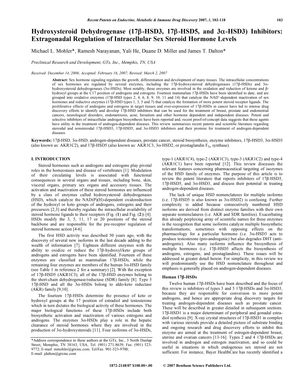Hydroxysteroid Dehydrogenase (17β-HSD3, 17β-HSD5, and 3α-HSD3) Inhibitors: Extragonadal Regulation of Intracellular Sex Steroid Hormone Levels
June 2007
in “
Recent Patents on Endocrine, Metabolic & Immune Drug Discovery
”

TLDR Certain inhibitors can potentially treat prostate cancer and other hormone-dependent conditions by controlling sex hormone levels in cells.
The document from 2007 reviews the development and potential therapeutic applications of inhibitors targeting hydroxysteroid dehydrogenases (HSDs), specifically 17β-HSD3, 17β-HSD5, and 3α-HSD3. These enzymes play a crucial role in the regulation of sex steroid hormone levels within cells. The review discusses various inhibitors, including Schering Plough's SCH-391, which showed potency in vitro and efficacy in reducing serum testosterone and tumor volume in mice, suggesting its potential in treating prostate cancer. Another inhibitor, SCH-659, demonstrated the ability to reduce serum testosterone and prostate weight in cynomolgus monkeys, indicating its potential for treating early-stage prostate disease with minimal side effects. Bristol-Myers Squibb identified potent 17β-HSD3 inhibitors through a high-throughput screening of over 200,000 small molecules. Endorecherche's discovery of 3α-HSD3's role in testosterone and dihydrotestosterone biosynthesis led to the identification of selective inhibitors for treating androgen-dependent disorders. Columbia University developed fluorogenic probes for cancer imaging targeting 17β-HSD5 and 3α-HSD3. The document also highlights EM-1404, a potent and selective 17β-HSD5 inhibitor with high oral bioavailability and no binding to other nuclear hormone receptors, suggesting its use for various androgen- or estrogen-dependent conditions. The importance of in vivo testing is emphasized to fully understand the therapeutic potential of these inhibitors.
